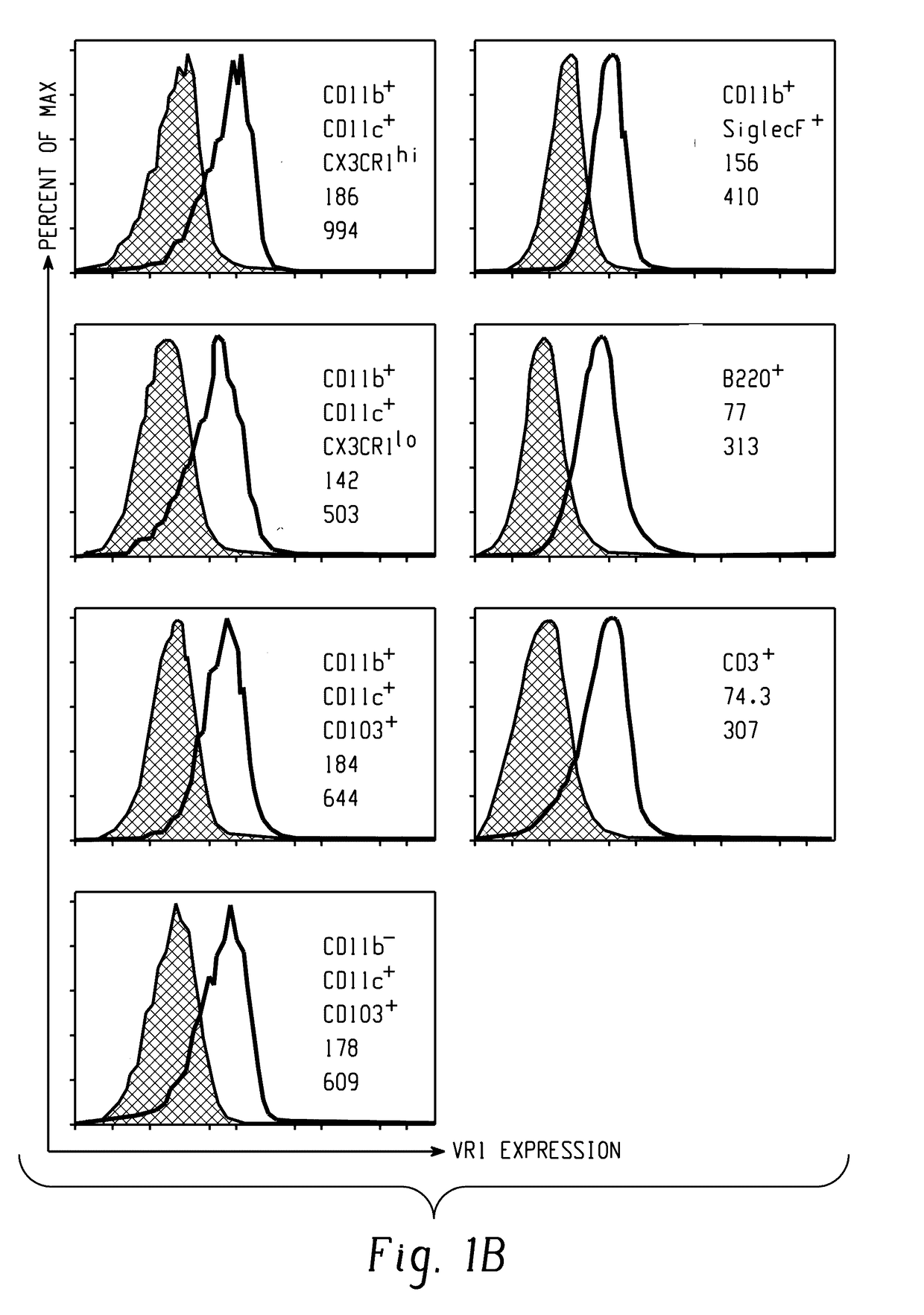Methods of treatment of inflammation of the gut
a gut inflammation and gut technology, applied in the direction of amide active ingredients, pharmaceutical delivery mechanisms, medical preparations, etc., can solve the problems of gastrointestinal inflammation, achieve the effects of improving immune homeostasis, improving gut inflammation symptoms, and improving immune homeostasis
- Summary
- Abstract
- Description
- Claims
- Application Information
AI Technical Summary
Benefits of technology
Problems solved by technology
Method used
Image
Examples
example 1
Expression of VR1 and CB2 on Cell Populations in the Small Intestinal Lamina Propria
[0058]The expression of endocannabinoid receptors VR1 and CB2 on the major cell populations in the small intestinal lamina propria (siLP). See FIG. 1A for the gating strategy. In addition to the lymphocytes (B220+ and CD3+ ), characterization of the mononuclear phagocytes (MNPs) was based on the expression of integrins CD11b (αM), CD11c (αX), CD103 (αE) and the chemokine receptor CX3CR1. Special attention was paid to the CX3CR1 phenotype since CX3CR1hi Mφ but not the CX3CR1lo cells play a significant role in immune homeostasis in the gut. To facilitate the identification of CX3CR1hi and CX3CR1lo cells, we used the CX3CR1gfp / + reporter mice where GFP expression is a marker for CX3CR1 expression. The MNPs expressed higher levels of VR1 and CB2 as compared to the lymphocytes and eosinophils. Strikingly, CX3CR1hi cells expressed higher level of VR1 and CB2 as compared to all other cells (FIG. 2A, FIGS. 1...
example 2
Oral Gavage with CP and AEA
[0060]We orally gavaged CX3CR1gfp / + mice with VR1 ligands CP or AEA. In case of CP (10 μg), its administration significantly increased the frequency of the regulatory CX3CR1hi Mφ but did not affect the frequency and number of the CX3CR1lo cells (FIG. 2D). Interestingly, feeding CP to CX3CR1gfp / gfp mice, i.e. mice which lack functional CX3CR1 protein, no changes in the frequency of the CX3CR1hi Mφ in the siLP were noted, demonstrating that VR1 mediated homeostasis of these Mφ requires the presence of functional CX3CR1 (FIG. 7). Similar to the observations with CP, feeding mice with AEA led to a significant increase in the frequency of CX3CR1hi Mφ (FIG. 2E). AEA is generated in the gut and its levels can be regulated by fatty acid amide hydrolase (FAAH), which catabolizes it (FIG. 2F) Inhibition of FAAH leads to increase in the levels of AEA. Treating mice with FAAH inhibitor PF3845 also led to an increase in the frequency of the CX3CR1hi Mφ (FIG. 2F), simil...
example 3
Effect of VR1 on the Tolerogenic Properties of siLP MNPs
[0061]Since IL10 is a cytokine with potent tolerogenic properties in the gut, we looked at the IL10 production as a measure of tolerogenicity in the CX3CR1hi Mφ and CD103+ DCs 24 hours after treatment with CP using the IL10 GFP-reporter mice. Compared to controls, the CX3CR1hi Mφ of CP fed mice showed a significant increase in the production of IL10 (FIG. 8A, left panel). In contrast the production of TNF-α, an pro-inflammatory cytokine, in the CX3CR1hi Mφ was decreased (FIG. 8A, right panel). Additionally, CP treatment of CX3CR1gfp / + mice led to a significantly increased expression of CX3CR1 on these Mφ (FIG. 8B). This was particularly important, as it has been shown earlier that the regulatory properties of CX3CR1hi Mφ depend on the expression of functional CX3CR1 protein itself. CP treatment also resulted in a modest but statistically significant increase in IL10 production in CD103+ DCs (FIG. 9).
[0062]The ability of CP to a...
PUM
| Property | Measurement | Unit |
|---|---|---|
| Dimensionless property | aaaaa | aaaaa |
| Dimensionless property | aaaaa | aaaaa |
| Body weight | aaaaa | aaaaa |
Abstract
Description
Claims
Application Information
 Login to View More
Login to View More - R&D
- Intellectual Property
- Life Sciences
- Materials
- Tech Scout
- Unparalleled Data Quality
- Higher Quality Content
- 60% Fewer Hallucinations
Browse by: Latest US Patents, China's latest patents, Technical Efficacy Thesaurus, Application Domain, Technology Topic, Popular Technical Reports.
© 2025 PatSnap. All rights reserved.Legal|Privacy policy|Modern Slavery Act Transparency Statement|Sitemap|About US| Contact US: help@patsnap.com



